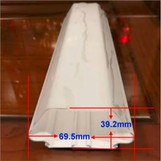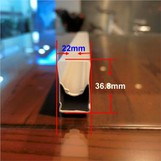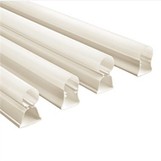Hey there! I'm an industry insider and a supplier of Modified ABS. Picking the right Modified ABS for your application can be a bit of a head - scratcher, but don't worry, I'm here to walk you through it.
First off, let's talk about what Modified ABS is. ABS stands for Acrylonitrile Butadiene Styrene. It's a common thermoplastic polymer that's known for its toughness, rigidity, and good processability. Modified ABS takes these basic properties and tweaks them to fit specific needs. There are various types of modifications, and each one has its own set of pros and cons.
Consider Your Application Requirements
The very first step in choosing the right Modified ABS is to understand what your application needs. Are you looking for something to withstand high temperatures? Or maybe you need a material that can resist flames?
High - Temperature Resistance
If your application involves high - temperature environments, you'll want to focus on Modified ABS that has enhanced heat resistance. For instance, some Modified ABS formulations can handle temperatures up to 100°C or even higher without losing their structural integrity. This is crucial for applications like automotive under - the - hood components, where the engine generates a lot of heat.
Flame Retardancy
When safety is a top concern, especially in applications like electrical enclosures or building materials, Flame Retardant ABS is your go - to option. These modified plastics are designed to slow down or even stop the spread of fire. They often contain special additives that release gases when exposed to flames, which can smother the fire and prevent it from spreading.
Mechanical Strength
If your project requires a material with high mechanical strength, Reinforced Modified ABS might be the best choice. Reinforcement can be done using materials like glass fibers or carbon fibers. These fibers add stiffness and strength to the ABS, making it suitable for applications like sports equipment or industrial machinery parts.
Evaluate the Processing Conditions
Another important factor is how you're going to process the Modified ABS. Different types of Modified ABS have different processing requirements.
Injection Molding
Injection molding is one of the most common ways to process ABS. If you're using injection molding, you need to consider the melt flow index (MFI) of the Modified ABS. A higher MFI means the plastic can flow more easily through the mold, which is great for complex shapes. However, if the MFI is too high, the part might not have the best mechanical properties. You'll also want to pay attention to the mold shrinkage rate. Some Modified ABS materials shrink more than others during the cooling process, which can affect the final dimensions of your part.
Extrusion
Extrusion is used to make products like pipes and sheets. When using extrusion, you need to make sure the Modified ABS has good melt strength. This ensures that the material can maintain its shape as it's being pushed through the extruder. You'll also need to consider the die swell, which is the expansion of the extruded material after it leaves the die.


Think About the Aesthetic Requirements
The look of your final product matters too. Depending on your application, you might need a glossy finish, a matte finish, or a specific color.
Surface Finish
Some Modified ABS materials can be easily polished to achieve a high - gloss finish, which is great for consumer products like electronic devices or automotive interior parts. On the other hand, if you prefer a more subdued look, there are options for matte finishes. These can be achieved through special additives or surface treatments.
Color
Most Modified ABS materials can be easily colored using pigments. You can get a wide range of colors, from bright and bold to more muted tones. Just make sure the colorant you choose is compatible with the Modified ABS formulation. Some colorants can affect the mechanical properties or the chemical resistance of the plastic.
Cost Considerations
Let's face it, cost is always a factor. The price of Modified ABS can vary depending on the type of modification, the raw materials used, and the supplier. You need to balance your budget with the performance requirements of your application. Sometimes, a slightly more expensive Modified ABS can save you money in the long run by reducing production waste or improving the durability of your product.
Look at the Chemical Resistance
Depending on your application, your Modified ABS might be exposed to various chemicals. You need to make sure the material can resist these chemicals without degrading. For example, if your product will be in contact with solvents or cleaning agents, you'll want to choose a Modified ABS with good chemical resistance.
Check the Regulatory Requirements
There are often regulations that your product needs to comply with, especially in industries like food packaging, medical devices, or automotive. Make sure the Modified ABS you choose meets all the relevant regulatory standards. This might include things like FDA approval for food - contact applications or RoHS compliance for electronic products.
Supplier Reputation
As a Modified ABS supplier, I know how important it is to choose a reliable supplier. You want a supplier who can provide consistent quality, technical support, and on - time delivery. Look for suppliers with a good track record in the industry. Read reviews from other customers and ask for samples before making a large order.
Conclusion
Choosing the right Modified ABS for your application is a multi - step process. You need to consider your application requirements, processing conditions, aesthetic needs, cost, chemical resistance, regulatory requirements, and the supplier's reputation. By taking the time to evaluate all these factors, you can make an informed decision that will result in a high - quality product.
If you're still not sure which Modified ABS is right for you, don't hesitate to reach out. We're here to help you find the perfect solution for your project. Whether you need Reinforced Modified ABS, Flame Retardant ABS, or Electroplating Grade ABS, we've got you covered. Contact us to start a conversation about your specific needs and let's work together to bring your project to life.
References
- "Plastics Engineering Handbook of the Society of Plastics Engineers"
- "Handbook of Thermoplastics"
- Industry reports on Modified ABS applications




